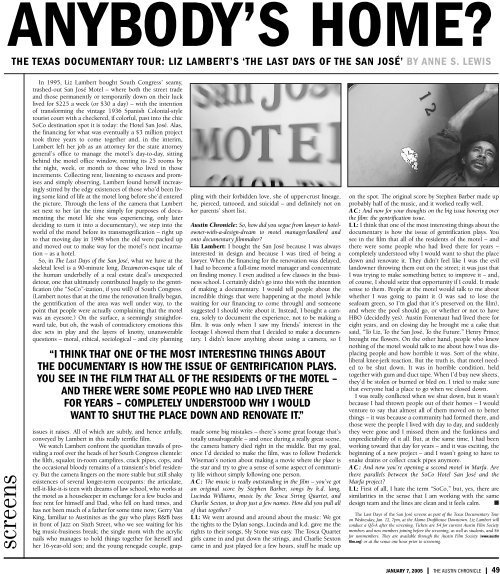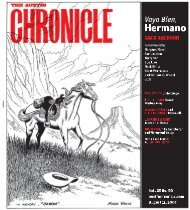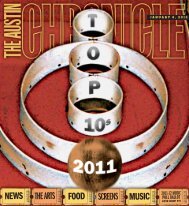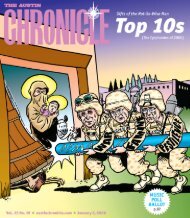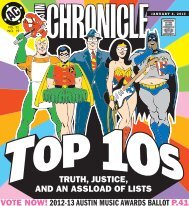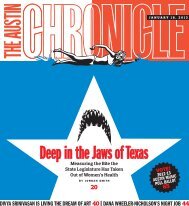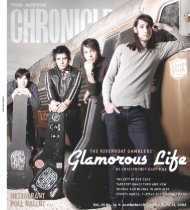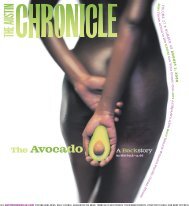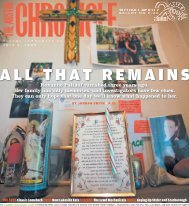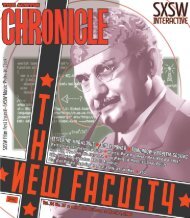Jan. 15 - The Austin Chronicle
Jan. 15 - The Austin Chronicle
Jan. 15 - The Austin Chronicle
- No tags were found...
You also want an ePaper? Increase the reach of your titles
YUMPU automatically turns print PDFs into web optimized ePapers that Google loves.
ANYBODY’S HOME?THE TEXAS DOCUMENTARY TOUR: LIZ LAMBERT’S ‘THE LAST DAYS OF THE SAN JOSÉ’ BY ANNE S. LEWISJANUARY 7, 2005 | THE AUSTIN CHRONICLE | 49screensIn 1995, Liz Lambert bought South Congress’ seamy,trashed-out San José Motel – where both the street tradeand those permanently or temporarily down on their lucklived for $225 a week (or $30 a day) – with the intentionof transforming the vintage 1936 Spanish Colonial-styletourist court with a checkered, if colorful, past into the chicSoCo destination spot it is today: the Hotel San José. Alas,the financing for what was eventually a $3 million projecttook three years to come together and, in the interim,Lambert left her job as an attorney for the state attorneygeneral’s office to manage the motel’s day-to-day, sittingbehind the motel office window, renting its 25 rooms bythe night, week, or month to those who lived in thoseincrements. Collecting rent, listening to excuses and promisesand simply observing, Lambert found herself increasinglystirred by the edgy existences of those who’d been livingsome kind of life at the motel long before she’d enteredthe picture. Through the lens of the camera that Lambertset next to her (at the time simply for purposes of documentingthe motel life she was experiencing, only laterdeciding to turn it into a documentary), we step into theworld of the motel before its transmogrification – right upto that moving day in 1998 when the old were packed upand moved out to make way for the motel’s next incarnation– as a hotel.So, in <strong>The</strong> Last Days of the San José, what we have at theskeletal level is a 90-minute long, Decameron-esque tale ofthe human underbelly of a real estate deal’s unexpecteddetour, one that ultimately contributed hugely to the gentrification(the “SoCo”-ization, if you will) of South Congress.(Lambert notes that at the time the renovation finally began,the gentrification of the area was well under way, to thepoint that people were actually complaining that the motelwas an eyesore.) On the surface, a seemingly straightforwardtale, but oh, the wash of contradictory emotions thisdoc sets in play and the layers of knotty, unanswerablequestions – moral, ethical, sociological – and city planningissues it raises. All of which are subtly, and hence artfully,conveyed by Lambert in this really terrific film.We watch Lambert confront the quotidian travails of providinga roof over the heads of her South Congress clientele:the filth, squalor, in-room campfires, crack pipes, cops, andthe occasional bloody remains of a transient’s brief residency.But the camera lingers on the more stable but still shakyexistences of several longer-term occupants: the articulate,tell-it-like-it-is teen with dreams of law school, who works atthe motel as a housekeeper in exchange for a few bucks andfree rent for himself and Dad, who fell on hard times, andhas not been much of a father for some time now; Gerry VanKing, familiar to <strong>Austin</strong>ites as the guy who plays R&B bassin front of Jazz on Sixth Street, who we see waiting for hisbig music-business break; the single mom with the acrylicnails who manages to hold things together for herself andher 16-year-old son; and the young renegade couple, grapplingwith their forbidden love, she of upper-crust lineage,he, pierced, tattooed, and suicidal – and definitely not onher parents’ short list.<strong>Austin</strong> <strong>Chronicle</strong>: So, how did you segue from lawyer to hotelowner-with-a-design-dreamto motel manager/landlord andonto documentary filmmaker?Liz Lambert: I bought the San José because I was alwaysinterested in design and because I was tired of being alawyer. When the financing for the renovation was delayed,I had to become a full-time motel manager and concentrateon finding money. I even audited a few classes in the businessschool. I certainly didn’t go into this with the intentionof making a documentary. I would tell people about theincredible things that were happening at the motel [whilewaiting for our financing to come through] and someonesuggested I should write about it. Instead, I bought a camera,solely to document the experience, not to be making afilm. It was only when I saw my friends’ interest in thefootage I showed them that I decided to make a documentary.I didn’t know anything about using a camera, so I“I THINK THAT ONE OF THE MOST INTERESTING THINGS ABOUTTHE DOCUMENTARY IS HOW THE ISSUE OF GENTRIFICATION PLAYS.YOU SEE IN THE FILM THAT ALL OF THE RESIDENTS OF THE MOTEL –AND THERE WERE SOME PEOPLE WHO HAD LIVED THEREFOR YEARS – COMPLETELY UNDERSTOOD WHY I WOULDWANT TO SHUT THE PLACE DOWN AND RENOVATE IT.”made some big mistakes – there’s some great footage that’stotally unsalvageable – and once during a really great scene,the camera battery died right in the middle. But my goal,once I’d decided to make the film, was to follow FrederickWiseman’s notion about making a movie where the place isthe star and try to give a sense of some aspect of communitylife without simply following one person.AC: <strong>The</strong> music is really outstanding in the film – you’ve gotan original score by Stephen Barber, songs by k.d. lang,Lucinda Williams, music by the Tosca String Quartet, andCharlie Sexton, to drop just a few names. How did you pull allof that together?LL: We went around and around about the music: We gotthe rights to the Dylan songs, Lucinda and k.d. gave me therights to their songs, Sly Stone was easy. <strong>The</strong> Tosca Quartetgirls came in and put down the strings, and Charlie Sextoncame in and just played for a few hours, stuff he made upon the spot. <strong>The</strong> original score by Stephen Barber made upprobably half of the music, and it worked really well.AC: And now for your thoughts on the big issue hovering overthe film: the gentrification issue.LL:I think that one of the most interesting things about thedocumentary is how the issue of gentrification plays. Yousee in the film that all of the residents of the motel – andthere were some people who had lived there for years –completely understood why I would want to shut the placedown and renovate it. <strong>The</strong>y didn’t feel like I was the evillandowner throwing them out on the street; it was just thatI was trying to make something better, to improve it – and,of course, I should seize that opportunity if I could. It madesense to them. People at the motel would talk to me aboutwhether I was going to paint it (I was sad to lose theseafoam green, so I’m glad that it’s preserved on the film),and where the pool should go, or whether or not to haveHBO (decidedly yes). <strong>Austin</strong> Fontenaut had lived there foreight years, and on closing day he brought me a cake thatsaid, “To Liz, To the San José, To the Future.” Henry Princebrought me flowers. On the other hand, people who knewnothing of the motel would talk to me about how I was displacingpeople and how horrible it was. Sort of the white,liberal knee-jerk reaction. But the truth is, that motel neededto be shut down. It was in horrible condition, heldtogether with gum and duct tape. When I’d buy new sheets,they’d be stolen or burned or bled on. I tried to make surethat everyone had a place to go when we closed down.I was really conflicted when we shut down, but it wasn’tbecause I had thrown people out of their homes – I wouldventure to say that almost all of them moved on to betterthings – it was because a community had formed there, andthose were the people I lived with day to day, and suddenlythey were gone and I missed them and the funkiness andunpredictability of it all. But, at the same time, I had beenworking toward that day for years – and it was exciting, thebeginning of a new project – and I wasn’t going to have tosnake drains or collect crack pipes anymore.AC: And now you’re opening a second motel in Marfa. Arethere parallels between the SoCo Hotel San José and theMarfa project?LL: First of all, I hate the term “SoCo,” but, yes, there aresimilarities in the sense that I am working with the samedesign team and the lines are clean and it feels calm. ■<strong>The</strong> Last Days of the San José screens as part of the Texas Documentary Touron Wednesday, <strong>Jan</strong>. 12, 7pm, at the Alamo Drafthouse Downtown. Liz Lambert willconduct a Q&A after the screening. Tickets are $4 for current <strong>Austin</strong> Film Societymembers and new members joining before the screening, as well as students, and $6for nonmembers. <strong>The</strong>y are available through the <strong>Austin</strong> Film Society (www.austinfilm.org) or at the venue one hour prior to screening.


